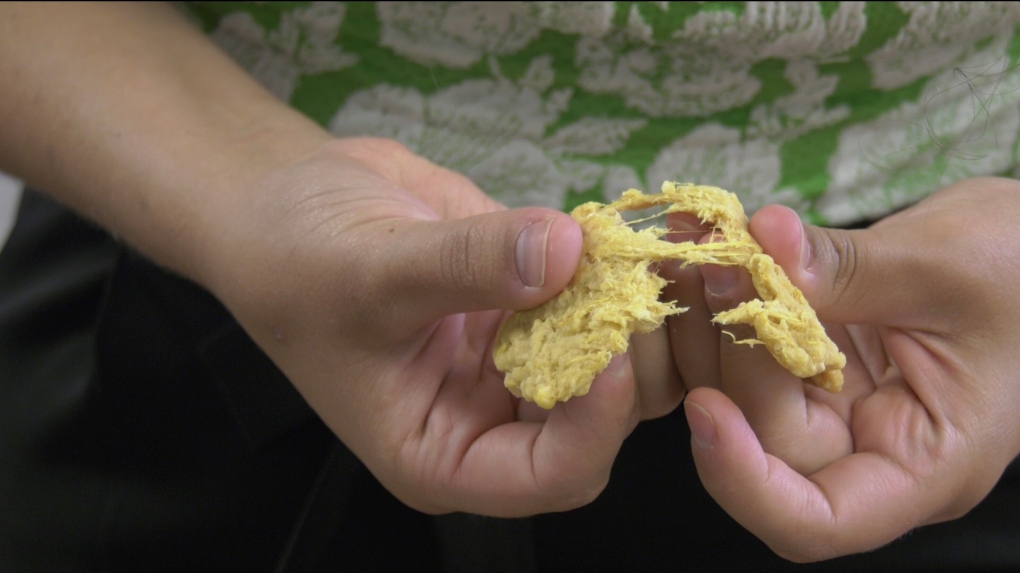How University of Guelph researchers are making a more ‘meaty’ plant-based meat
Making plant-based meats more “meaty” – that’s the focus of a team of researchers at the University of Guelph.
Employing a “mechanical mouth” and corn waste protein, the scientists have found a potentially cheaper and simpler alternative to current plant-based meat-making techniques.
 The “mechanical mouth” bites down on a piece of plant-based meat manufactured in a University of Guelph lab. (Spencer Turcotte/CTV News)
The “mechanical mouth” bites down on a piece of plant-based meat manufactured in a University of Guelph lab. (Spencer Turcotte/CTV News)
“It almost replicates the first two bites of chewing,” says food science PhD student Stacie Dobson describing how the team’s “mechanical mouth” works.
They have created meat-like analogues that mimic the chewy texture and "mouth feel" of beef or chicken.
“So we can get elements like hardness, chewiness.”
Those textures are something plant-based meats on the market often lack.
“Those are all sorts of ground proteins that are stuck together with a type of starch or cellulosics that kind of bind everything in that way. So it doesn't have those whole muscle fibres,” Dobson explains.
But the University of Guelph’s plant-based meat is different, thanks to a corn protein called zein.
“It's often a waste product that's used in animal feed or in fertilizers, but this protein has these stretchy fibre-like properties within itself when you just add water and about 40 degrees and a bit of dilute acid,” Dobson says.
With those fibrous textures, it feels like biting into tissue.
“We can see those fibres that are definitely part of it,” Dobson says as she pulls a piece apart.
 Fibrous texture is one of the things that set the University Guelph’s plant-based meat apart from others on the market. (Spencer Turcotte/CTV News)
Fibrous texture is one of the things that set the University Guelph’s plant-based meat apart from others on the market. (Spencer Turcotte/CTV News)
Aside from the texture, the team says their meat-making method involves cheaper processing costs, which could ultimately mean lower prices for consumers.
There are environmental benefits too, considering the simpler more sustainable technology compared to current methods.
The team of researchers is now looking for a partner to help scale up production and nail down flavour.
“Because it uses such mild ingredients, you can almost add whatever flavour profile you want,” Dobson says.
CTVNews.ca Top Stories

DEVELOPING Driver 'hell-bent on carnage' has died after killing 10 on New Year's Day in New Orleans, AP sources say
The suspect who drove a vehicle at high speed into a crowd of revellers in New Orleans on New Year's Day was killed after a firefight with police, law enforcement officials told the AP.
Financial changes in Canada you should know about this year
There are a few changes in federal policies that could affect Canadians' finances in the new year.
Ukraine halts transit of Russian gas to Europe after a prewar deal expired
Ukraine on Wednesday halted Russian gas supplies to European customers that pass through the country, almost three years into Moscow's all-out invasion of its neighbor, after a prewar transit deal expired at the end of last year.
Here are some of the new laws and rules coming into effect in Canada in 2025
From boosting child and disability benefits to increasing protections for workers, here’s a look at new measures coming into effect in 2025.
A single cigarette slashes 20 minutes off your life expectancy, U.K. research suggests
If you're thinking about making a New Year's resolution to quit smoking, it might help to know that new research says it could extend your life expectancy.
From a mini fridge to a toy doll, here's what has been lost on public transit in Ontario this year
Most people understand the pain that comes with leaving a phone, wallet or umbrella behind on-board public transit and the despair of whether or not it'll ever be found again. Well, outside of those commonly forgotten valuables, items like a porcelain doll, Mac DeMarco vinyl record, mini-fridge, or a toaster oven with food still inside have also been left behind on public transit this year.
The woman who was burned to death inside a New York City subway has been identified
The woman who died after being set on fire in a New York subway train earlier this month was a 57-year-old from New Jersey, New York City police announced Tuesday.
11 architecture projects set to shape the world in 2025
From innovative timber buildings to one of Asia’s largest new airports, here are 11 projects opening in the next 12 months.
What's open and closed on New Year's Day in Canada
As Canadians take time off to celebrate, many federal offices, stores and businesses will be closed across the country on New Year's Day.

































